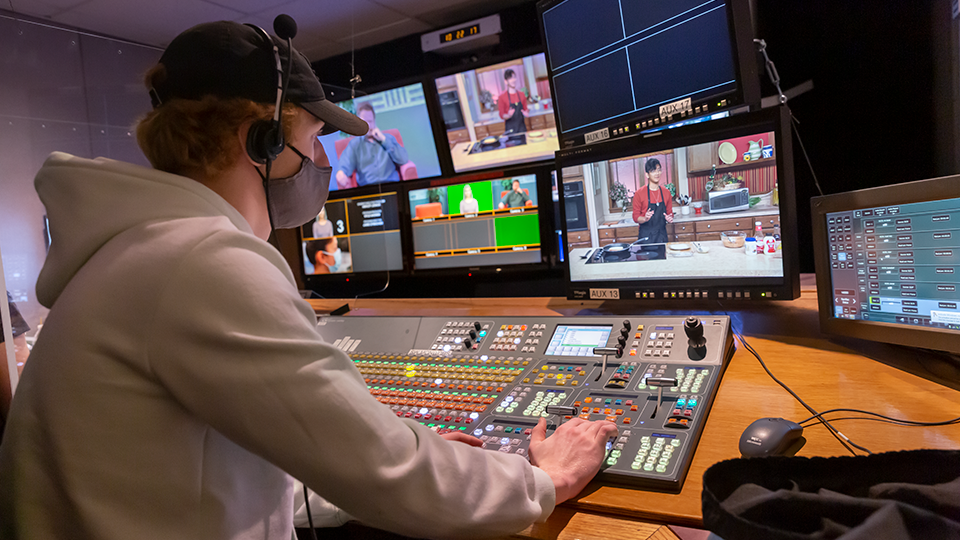Why understanding your audience improves your Video Production results
Exploring the most up to date Fads in Video Production for 2025
As we approach 2025, the video production landscape is positioned for considerable evolution, identified by improvements in enhanced reality and AI-driven editing and enhancing devices. The integration of interactive narration and immersive 360-degree experiences is redefining audience interaction, while sustainable production methods acquire prominence. Furthermore, enhanced online streaming capabilities are established to equalize material access like never ever before. These advancements raise vital questions regarding the future of creativity and innovation in video production-- what effects will these patterns hold for consumers and makers alike?
Augmented Truth in Video Production
Increased reality (AR) is positioned to transform video production by seamlessly blending electronic components with live-action footage. This ingenious modern technology enhances narration by giving immersive experiences that involve audiences on a much deeper degree. AR allows filmmakers to integrate interactive graphics, computer animations, and details overlays straight into the real-world atmosphere recorded on display, creating a dynamic seeing experience that standard approaches can not achieve.
In 2025, we can expect AR to end up being an indispensable part of different video production procedures, from pre-production preparation to post-production improvements. The ability to visualize complex scenes and aspects in real-time will certainly make it possible for supervisors and cinematographers to make enlightened choices throughout filming. Furthermore, AR can assist in remote partnership, enabling employee to communicate with 3D designs and visual effects from different locations, thereby improving the production process.
Marketing and promotional approaches will profit from AR combination, as brand names progressively leverage this technology to produce special and interesting material. As consumer need for innovative and interactive experiences remains to expand, AR will play a vital function in shaping the future of video production, driving creative thinking and broadening the possibilities for filmmakers.
AI-Powered Editing And Enhancing Devices

Enhanced Automation Features
The rise of AI-powered modifying tools is set to revolutionize the video production landscape, improving process and improving innovative possibilities. These boosted automation functions are developed to reduce manual labor, enabling content creators to concentrate much more on narration and creative vision. By leveraging maker learning algorithms, these tools can examine footage, determine essential minutes, and recommend optimal cuts, considerably decreasing editing and enhancing time.
Among one of the most amazing advancements is the capability of AI to comprehend and adjust to various modifying styles. This capability makes it possible for editors to apply certain visual appeals or genres to their tasks efficiently, facilitating a much more customized strategy. AI-driven shade grading and sound editing and enhancing tools can automatically boost audio and aesthetic quality, making certain a professional surface without extensive manual modifications.
Additionally, the combination of automated attributes in video editing software application enables seamless assimilation with other production aspects, such as changes and graphics, making the modifying procedure extra cohesive. As these devices proceed to evolve, they promise to democratize video production, making it possible for customers of all skill degrees to create top notch content rapidly and successfully, inevitably changing the sector for years ahead.
Real-Time Cooperation Benefits
Real-time collaboration is ending up being progressively essential in video production, specifically with the arrival of AI-powered editing and enhancing tools. These innovative modern technologies make it possible for numerous stakeholders, including customers, directors, and editors, to function with each other flawlessly, no matter their physical places. By facilitating instantaneous responses and alterations, AI-powered systems enhance the creative procedure, allowing groups to choose quickly and successfully.
Among the vital advantages of real-time cooperation is the capacity to take advantage of AI for data-driven insights. As an example, AI formulas can evaluate video and suggest edits or changes that line up with the project's vision, simplifying the workflow. This not just speeds up the editing procedure however also assures that innovative selections are notified by historical data and market fads.
Real-time partnership cultivates a more inclusive atmosphere, urging varied perspectives and ideas. Group members can contribute their expertise, enhancing the overall top quality of the production. As video jobs end up being progressively intricate, the requirement for natural synergy is vital, and AI-powered editing tools are revolutionizing exactly how imaginative professionals work together. Inevitably, these developments in real-time collaboration are positioned to redefine the landscape of video production in 2025 and past.

Improved User User Interface
Ingenious individual interfaces in AI-powered modifying devices are changing the video production landscape by improving the individual experience and enhancing workflows. These devices leverage progressed formulas to simplify intricate editing and enhancing jobs, enabling developers to concentrate a lot more on storytelling and creative thinking as opposed to technological complexities.
One crucial development is the assimilation of intuitive drag-and-drop performances, which make it possible for users to construct their projects effortlessly. Coupled with real-time comments devices, editors can visualize modifications promptly, decreasing the moment invested on revisions. On top of that, AI-driven functions such as computerized scene detection and intelligent color grading supply suggestions based on job context, substantially increasing the editing and enhancing procedure.
In addition, the rise of adjustable user interfaces allows individuals to tailor their office to fit specific choices, boosting performance and efficiency. For example, editors can focus on devices and functions they make use of most often, minimizing diversions and maximizing process fluidity.
As these AI-powered editing and enhancing devices remain to develop, their boosted individual interfaces are readied to redefine sector requirements, making premium video production accessible to a broader series of developers. This trend not only democratizes video editing and enhancing yet also cultivates development in material creation, setting the phase for exciting growths in 2025 and beyond.
Interactive Narration Methods
As video production progresses, interactive storytelling techniques are coming to be essential for producing immersive customer experiences. By incorporating branching narrative structures, creators can provide audiences a tailored trip through the web content, improving interaction. Additionally, real-time target market participation enables for vibrant storytelling that adapts to visitor selections, fostering a much deeper connection with the product.
Immersive Viewer Experiences
The advancement of immersive audience experiences is revolutionizing the landscape of interactive narration techniques, enabling target markets to engage with stories in unmatched means. By integrating digital truth (VIRTUAL REALITY), enhanced truth (AR), and mixed reality (MR) technologies, designers are crafting atmospheres where visitors do not merely observe stories but actively take part in them. This shift towards immersion promotes a feeling of presence and emotional financial investment, transforming easy intake right into dynamic exploration.
Innovations in 360-degree video and spatial audio even more improve these experiences, allowing individuals to navigate and engage with their environments. Such technologies help with a multi-sensory method to narration, where aesthetic and acoustic elements are delicately woven together to develop a cohesive narrative. This not only mesmerizes the target market but also motivates much deeper links to the content.
The surge of interactive platforms is equipping developers to experiment with non-linear narratives, supplying target markets the ability to influence outcomes and personality arcs in genuine time. As immersive customer experiences proceed to progress, they are readied to redefine how stories are informed and received, leading the way for cutting-edge forms of web content that resonate with diverse audiences across the world.
Branching Narrative Frameworks
Structure upon the immersive customer experiences that have transformed interactive narration, branching narrative structures are becoming an effective method to even more engage target markets. These frameworks permit visitors to affect the direction of the narrative, producing a much more customized and dynamic experience. By offering multiple paths and results, material creators can satisfy diverse target market choices and foster deeper psychological connections with the product.
As innovation developments, the application of branching stories has ended up being more advanced. Modern systems enable smooth shifts in between options, boosting the customer's feeling of agency. This interactivity not just captivates audiences yet likewise urges repeated viewings, as individuals explore alternating stories and endings.
Moreover, branching stories can be efficiently integrated into different styles, from gaming to movie and educational material. This versatility opens new opportunities for narration, permitting creators to try out intricate character arcs and detailed plots. As we relocate right into 2025, the value of branching narrative structures in video production will likely remain to expand, improving just how stories are told and experienced, inevitably redefining the relationship in between makers and their target markets.
Real-Time Audience Engagement
Real-time target market involvement is reinventing interactive storytelling by enabling makers to attach with customers in unmatched means. This cutting-edge strategy permits target markets to influence narratives as they unfold, enhancing immersion and psychological financial investment. With innovations in technology, such as live polling, conversation assimilation, and boosted truth, customers can take part proactively, making selections that form the direction of the story in real-time.
Platforms leveraging these methods are not only redefining typical narration yet additionally promoting neighborhood communication. By including attributes like live Q&A sessions and interactive personality discussions, makers can build much deeper links with their audience, ensuring an extra tailored watching experience. Therefore, narratives come to be a lot more dynamic, adapting to target market comments and preferences instantaneously.
Furthermore, real-time engagement improves data collection, supplying useful insights into visitor habits and choices. This info can guide future manufacturings, refining web content approaches to better reverberate with target demographics. As we approach 2025, the assimilation of real-time target market engagement into video production will likely come to be a conventional practice, transforming how tales are told and experienced. The evolution of interactive storytelling is not merely an improvement; it is a vital change in the direction of a more interesting and participatory narrative framework.
360-Degree Video Experiences
Immersive video experiences are readied to redefine material consumption in 2025, as innovations in technology remain to blur the lines in between truth and online involvement. The increase of 360-degree video and increased fact (AR) is transforming just how target markets interact with material, developing chances for much deeper emotional links and customized narration.
With the spreading of inexpensive VR headsets and smart phones efficient in supporting high-grade immersive material, makers can currently produce videos that put visitors at the center of the activity. This change not just enhances audience involvement however additionally permits brands to create distinct experiences that resonate with their target audiences. Video Production. Traveling companies can use digital scenic tours of locations, while educational institutions can simulate complex environments for immersive learning.
The integration of interactive aspects in 360-degree videos makes it possible for customers to make options that affect the story, promoting a sense of firm and financial investment in the web content. As makers experiment with these technologies, we can expect a rise in ingenious storytelling methods that prioritize target market involvement. In this evolving landscape, the challenge will certainly be to stabilize creative vision with the technical needs of generating top notch immersive experiences.
Lasting Production Practices
As the video production landscape advances with ingenious technologies like 360-degree experiences, the industry is likewise increasingly prioritizing sustainable production techniques. Acknowledging the environmental influence of conventional filming approaches, production business are embracing environment-friendly efforts to decrease their carbon footprint.
One considerable trend is making use of eco-friendly energy sources, such as solar and wind power, to sustain production sets. This change not just decreases dependence on fossil gas however also reduces functional expenses in the lengthy run. Additionally, several companies are carrying out electronic procedures to restrict paper usage, therefore promoting an extra lasting workflow.

Collaboration with neighborhood communities and organizations likewise plays a necessary role in lasting methods, as it promotes regional economic situations and reduces transportation discharges. On the whole, the commitment to sustainability in video production shows a more comprehensive societal change in the direction of environmental stewardship, making sure that future generations can proceed to take pleasure in cinematic narration without endangering the planet's wellness.
Enhanced Online Streaming
The future of video production is being improved by enhanced live streaming capacities, which are transforming just how target markets involve with material. As modern technology advancements, online streaming is coming to be more interactive and accessible, allowing developers to link with visitors in real-time. This shift not only improves target market participation however likewise cultivates a feeling of community around shared experiences.
With the integration of high-definition video and audio top quality, combined with low-latency streaming, audiences now delight in seamless broadcasts that measure up to traditional television. Platforms are progressively including features such as multi-camera setups, interactive surveys, and target market Q&A sessions, making live events more appealing and dynamic.
In addition, the rise of decentralized streaming protocols assures far better reliability and scalability, allowing material designers to get to bigger target markets without compromising quality. As brand names and influencers take advantage of these developments, the potential for innovative advertising and marketing strategies through real-time streaming emerges
In 2025, we can anticipate more developments in augmented reality overlays and enhanced analytics, empowering makers to refine their material and tailor it to target market choices. Boosted real-time streaming is not just a pattern; it is a critical component forming the future of web content usage and production.
Online Reality Integration
With improved live streaming establishing the stage for more interactive experiences, digital fact (VIRTUAL REALITY) assimilation is positioned to take target market involvement to unprecedented levels. As we approach 2025, the merging of VR modern technology with video production is transforming just how web content is created and consumed. By involving customers in a 360-degree atmosphere, producers can offer special experiences that conventional styles can not match.
Brands are increasingly leveraging VR to produce engaging narratives that resonate deeply with target markets. This combination enables experiential advertising, where customers can interact with services or products in a virtual area, cultivating an extra individual connection. Events such as virtual shows, item launches, and immersive storytelling sessions are becoming commonplace, involving individuals in methods that improve retention and emotional financial investment.
Moreover, improvements in software and hardware are making VR extra easily accessible official site to developers, resulting in a broader array of content. As production expenses lower and user-friendly devices emerge, we can anticipate a surge in ingenious VR jobs throughout various fields, from home entertainment to education and learning. The future of video production exists in these immersive experiences, redefining storytelling and audience communication in the electronic landscape.
Regularly Asked Inquiries
What Are the Essential Skills for Video Producers in 2025?
Essential skills for video manufacturers in 2025 include innovative technical effectiveness in editing and enhancing software program, solid narration capabilities, versatility to emerging modern technologies, partnership abilities for diverse groups, and an eager understanding of audience engagement methods throughout systems.
Just How Can Independent Creators Access Advanced Video Production Technologies?
Independent makers can access innovative video production technologies via budget-friendly software application platforms, cloud-based editing tools, open-source sources, and online training courses. Partnerships with tech firms and leveraging community resources also boost access to sophisticated production tools.
What Are the Possible Costs Related To These New Video Production Trends?
The prospective expenses related to emerging video production trends can differ greatly, incorporating expenses for innovative equipment, software program licenses, training, and personnel. Budgeting efficiently is important for creators to leverage these technologies without spending beyond your means.
Exactly How Can I Measure the Success of My Video Production Initiatives?
To measure the success of your video production efforts, assess essential performance indications such as audience interaction, conversion prices, target market retention, and responses. Utilize analytics tools to collect information and derive workable insights for future renovations.
What Industries Are The Majority Of Influenced by Video Production Trends in 2025?
Industries such as marketing, enjoyment, education and learning, and healthcare are substantially affected by arising video production trends. Creative Video Production. These industries increasingly use innovative methods to boost involvement, enhance communication, and supply compelling content to their respective audiences
Ingenious individual interfaces in AI-powered editing and enhancing tools are changing the video production landscape by improving the individual experience and improving operations. As we come close to 2025, the assimilation of real-time audience engagement right into video production will likely come to be a basic practice, changing exactly how stories are informed and experienced. As the video production landscape advances with ingenious modern technologies like 360-degree experiences, the sector is also progressively focusing on lasting production practices. The future of video production is being reshaped by improved real-time streaming capabilities, which are revolutionizing just how audiences involve with web content. To measure the success of your video production efforts, evaluate vital performance indicators such as audience interaction, conversion rates, target market retention, and comments.